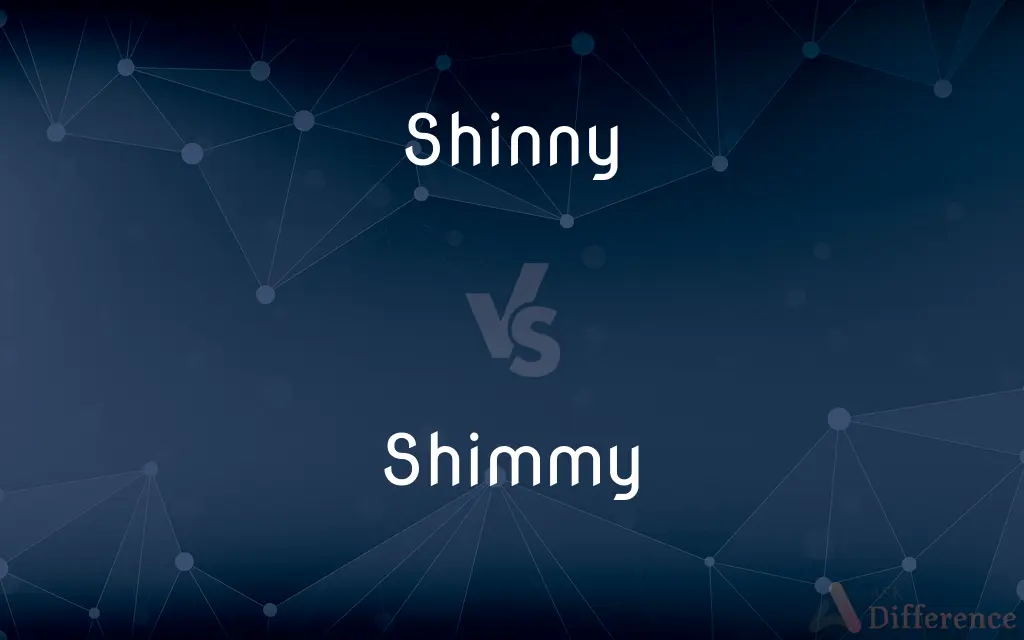Shinny vs. Shimmy — What's the Difference?
By Fiza Rafique & Urooj Arif — Updated on April 4, 2024
Shinny refers to an informal type of hockey played without standard equipment, while shimmy is a dance move involving rapid back-and-forth shoulder or hip shaking.

Difference Between Shinny and Shimmy
Table of Contents
ADVERTISEMENT
Key Differences
Shinny is a casual, often impromptu, form of hockey with minimal equipment, typically played on ice or the street, focusing on the enjoyment of the game rather than strict adherence to official rules. Whereas, shimmy involves a quick, vibrating movement of the body, usually the shoulders or hips, often seen in various dance styles as an expressive or celebratory movement.
In shinny, players might use makeshift items for pucks and sticks, and goals can vary from actual nets to any suitable markers. On the other hand, the shimmy is characterized by its specific technique requiring rapid, controlled movements, showcasing a dancer's skill and often used to convey emotion or add flair to a performance.
Shinny emphasizes the social and physical aspects of hockey, allowing players of various skill levels to participate without the need for protective gear or formal teams. In contrast, the shimmy, while accessible to dancers of all skill levels, demands a certain level of technique to be performed effectively, often incorporated into choreography in genres such as jazz, belly dance, and popular music videos.
The origins of shinny trace back to informal street games, capturing the essence of play and community engagement without the confines of organized sport. Shimmy, meanwhile, has a rich history in dance, with roots in cultures around the world, evolving over time into a widely recognized move in both social and professional dancing contexts.
Despite their vastly different domains, both shinny and shimmy embody a spirit of freedom and improvisation. Shinny breaks away from the structured world of competitive sports, while shimmy offers dancers a means to express individuality within the rhythm and flow of music.
ADVERTISEMENT
Comparison Chart
Definition
A form of informal hockey with minimal equipment and flexible rules.
A dance move involving rapid shaking or vibrating, usually of the shoulders or hips.
Context
Sports, particularly hockey.
Dance, across various styles and settings.
Technique
Uses makeshift equipment; emphasizes fun and participation.
Requires controlled, rapid movements; part of dance choreography.
Purpose
To enjoy the game of hockey in a casual, accessible manner.
To express emotion or add flair to dance performances.
Origins
Informal street or ice games.
Various cultural dances, evolving into a common move in modern dance.
Compare with Definitions
Shinny
Emphasizes fun over competition.
Shinny games are more about enjoying the game than keeping score.
Shimmy
Adds excitement to dance routines.
The choreography featured a shimmy move that captivated the audience.
Shinny
Accessible to players of all skill levels.
Shinny welcomes everyone, from beginners to experienced players.
Shimmy
Can be performed in many dance styles.
The shimmy is popular in both belly dancing and jazz.
Shinny
Can be played on ice or other surfaces.
Neighborhood kids organize shinny games in the parking lot.
Shimmy
A dance move with rapid shoulder or hip shaking.
The dancers began to shimmy in time with the upbeat music.
Shinny
Requires minimal equipment.
In shinny, any flat object can serve as a puck.
Shimmy
Requires technique and control.
Mastering the shimmy took her several dance classes.
Shinny
A casual game of hockey without formal rules.
We played shinny on the frozen pond with broomsticks for hockey sticks.
Shimmy
Expresses joy or celebration.
Winning the contest, she couldn't help but shimmy with happiness.
Shinny
Shinny (also shinney, pick-up hockey, pond hockey, or "outdoor puck") is an informal type of hockey played on ice. It is also used as another term for street hockey.
Shimmy
A shimmy is a dance move in which the body is held still, except for the shoulders, which are quickly alternated back and forth. When the right shoulder goes back, the left one comes forward.
Shinny
Ice, street, or field hockey played informally with a ball, can, or similar object.
Shimmy
Abnormal vibration or wobbling, as of the wheels of an automobile.
Shinny
The stick used when playing this game.
Shimmy
A dance popular in the 1920s, characterized by rapid shaking of the body.
Shinny
To climb by shinning.
Shimmy
A chemise.
Shinny
To climb in an awkward manner.
Shimmy
To vibrate or wobble abnormally.
Shinny
(Canada) An informal game of pickup hockey played with minimal equipment: skates, sticks and a puck or ball.
Shimmy
To shake the body in or as if in dancing the shimmy.
Shinny
(Canada) Street hockey.
Shimmy
To shinny. See Usage note below.
Shinny
Hockey.
Shimmy
A dance movement involving thrusting the shoulders back and forth alternately.
Shinny
A hockey-like game played by American Indians.
Shimmy
A dance that was popular in the 1920s.
Shinny
Climb awkwardly, as if by scrambling
Shimmy
An abnormal vibration, especially in the wheels of a vehicle.
Shimmy
(rare) A sleeveless chemise.
Shimmy
(dance) To perform a shimmy (dance movement involving thrusting the shoulders back and forth alternately).
Shimmy
To climb something (e.g. a pole) gradually (e.g. using alternately one's arms then one's legs).
He shimmied up the flagpole.
The static made her dress shimmy up her leg.
Shimmy
(intransitive) To vibrate abnormally, as a broken wheel.
Shimmy
To shake the body as if dancing the shimmy.
Shimmy
To move across a narrow ledge, either by hanging from it or by strafing on it along the wall.
Shimmy
A chemise.
Shimmy
An abnormal wobble in a motor vehicle (especially in the fromt wheels);
He could feel the shimmy in the steering wheel
Shimmy
A woman's sleeveless undergarment
Shimmy
Lively dancing (usually to ragtime music) with much shaking of the shoulders and hips
Shimmy
Tremble or shake;
His voice wobbled with restrained emotion
Shimmy
Dance a shimmy
Common Curiosities
Where is shinny typically played?
Shinny can be played on ice, in streets, or any suitable open space.
How does one perform a shimmy?
A shimmy is performed by quickly shaking or vibrating the shoulders or hips back and forth.
Is special equipment needed for shinny?
No, shinny is characterized by the use of makeshift or minimal equipment.
Can anyone do a shimmy?
While accessible, performing a shimmy well requires practice and control over one's movements.
What is a shimmy in dance?
A shimmy is a dance move involving rapid, vibrating movements of the body, particularly the shoulders or hips.
What are the social aspects of shinny?
Shinny is highly social, emphasizing community engagement and enjoyment over competition.
What skills does a shimmy enhance in dance?
A shimmy improves a dancer's control, rhythm, and ability to express emotion through movement.
How does shinny differ from traditional hockey?
Shinny differs in its informal nature, lack of full teams, standard equipment, and formalized rules.
How do players keep score in shinny?
Scoring can vary; some games may not keep score, focusing instead on the fun of playing.
Why is the shimmy popular in dance?
Its ability to convey energy and emotion makes the shimmy a popular choice in dance routines.
What is shinny?
Shinny is an informal, simplified version of hockey played without official equipment or strict rules.
Is shimmying limited to certain dance genres?
No, the shimmy is found in various dance styles worldwide, from belly dancing to contemporary pop.
What makes shinny appealing to communities?
Its accessibility, low cost, and emphasis on fun and social interaction make shinny appealing to a wide range of participants.
Do you need to know how to skate to play shinny?
While helpful, beginners and non-skaters can also participate in shinny, especially in non-ice versions.
Can shimmy be a part of formal dance performances?
Yes, the shimmy is often featured in choreographed dance routines across many performance styles.
Share Your Discovery

Previous Comparison
Decrescendo vs. Diminuendo
Next Comparison
Advice vs. ConsultationAuthor Spotlight
Written by
Fiza RafiqueFiza Rafique is a skilled content writer at AskDifference.com, where she meticulously refines and enhances written pieces. Drawing from her vast editorial expertise, Fiza ensures clarity, accuracy, and precision in every article. Passionate about language, she continually seeks to elevate the quality of content for readers worldwide.
Co-written by
Urooj ArifUrooj is a skilled content writer at Ask Difference, known for her exceptional ability to simplify complex topics into engaging and informative content. With a passion for research and a flair for clear, concise writing, she consistently delivers articles that resonate with our diverse audience.














































